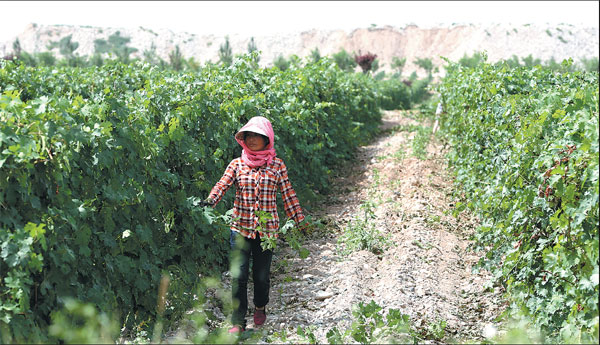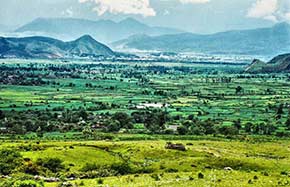Vineyards bring green to Gobi
Emerging industry has created protective greenbelt for region's environment, Yuan Shenggao reports.
The vineyards along the Helan Mountain have brought greenery back to the dry inland areas of the Ningxia Hui autonomous region, with its wine industry adding strength to local environmental protection efforts.
Yinchuan, capital of Ningxia in Northwest China, is one of the country's driest areas, but the east foothills of the Helan Mountain, located within the city, are now regarded as one of the best and most promising wine regions for quality grapes in China.
The east foothills have a unique soil, with annual rainfall of less than 200 millimeters, but are easily irrigated with water from the Yellow River that passes through the region. This provides rare, good conditions for grape planting. However, the region still faces the threat of desertification.
 |
|
Vineyards along the Helan Mountain have helped in the improvement of the local environment. Feng Yongbin / China Daily |
The vast grape-planting in vineyards along the Helan Mountain and the protective surrounding greenbelts have improved the environment by consolidating and stabilizing the soil, forming a microclimate, experts and vineyard managers have found.
"It resembled the Gobi Desert, with huge stones scattered across the surface over 20 years ago and hit by sandstorms frequently," said Liu Hai, owner of Chateau Legacy Peak, a vineyard along the Helan Mountain. "Then my parents rented this vast tract of land, transforming it into a vineyard since the 1990s."
His parents removed the large rocks and dug the surface soil down to about 0.5 to 1 meter deep. They then upgraded the subsoil with manure and fertilizers, which is common practice in transforming the desert-like areas along the Helan Mountain into vineyards.
"The digging and removing of surface soil is not harmful for the environment, but is actually good for it," said Wang Zhenping, professor at the School of Agriculture, Ningxia University.
"The vines usually root in very deep to obtain nutrients in the soil, which prevents both soil erosion and sand being generated from the surface, which is beneficial for the environment," he said.
In addition, the owners always plant trees around the vineyards to keep out the wind and cold, which also protects the soil and environment, Wang added. "There are few sandstorms in my vineyard and it has formed a microclimate, creating a much better environment than before," said Liu, the vineyard owner.
The huge rocks removed from the land are used as construction materials when building chateaux and cellars for the wine.
In the past, Ningxia experienced economic growth at the cost of environmental pollution and huge resources consumption, putting pressure on sustainable development. But, the wine industry could be a green industry, not just bringing green to Gobi Desert, but also being environmentally friendly, said Cao Kailong, head of the Administration of Development of the Grape Industry of Ningxia.
The grapevines, stalks, marc and lees - all winemaking by-products - can be used as fertilizer or extracted for essential oils, "pollution free and zero emissions", Cao said.
"The vineyards and chateaux along the Helan Mountain have become a major protective belt for the environment and have formed beautiful scenery," he said, adding that soil erosion has greatly reduced in recent years.
The Ningxia government has strengthened its monitoring of the industry's development, considering many chateaux and vineyards are adjacent or located within the Helan Mountain national natural reserve.
More than 1,700 hectares that were previously earmarked for a grape-themed town have been removed from the plans and returned to the reserve's jurisdiction.
Cao said that overall, the vineyards could play a big role in improving the local environment. Ningxia is planning to build a national pilot zone for ecological development along the Helan Mountain, to remind people to protect precious greenery in the dry northwestern regions.
What they say
Ningxia's raw material is impressively consistent. The wines have an attractive frankness of fruit, rarely more than 13 percent alcohol, nicely balanced by natural acidity and - oxidation apart - were generally both clean and expressive.
Jancis Robinson, Master of Wine, British wine critic, journalist and wine writer
The quality of the wines of Ningxia has surprised me, as they are probably one of the best of China. The potential near Helan Mountain is high. The wineries are often equipped with modern and technological equipment. But the most impressive is the passion for wine that the enologists and the wine workers showed, and their desire to learn and understand winemaking.
Pierre Viala, French winemaker
Ningxia is a very young wine region with huge potential. The development pattern of the "small wineries, large producing area" that the Ningxia government advocated was also great. It also introduced the Grand Cru system not long ago. These were a good start. Although it's still too early to say how far this place will go, Ningxia will certainly become an important place on the world wine map in 10 or 15 years. Ningxia is unique, and it should use the terroir here to make the wine region one of the best.
Nova McCune Cadamatre, winemaker from the United States
- Alxa Right Banner: A camel town in the Gobi desert
- Gobi jades’ unique craftsmanship and features
- China to help Mongolia in rare Gobi bear protection
- Gobi has been found! Marathon-running stray dog reunites with owner
- Flower industry turns Gobi wilderness into attractive landscape
- Gobi Red Bactrian camels race in Inner Mongolia
- Gansu to hold Gobi cross-country race in honor of legendary monk Xuanzang

























